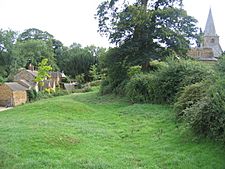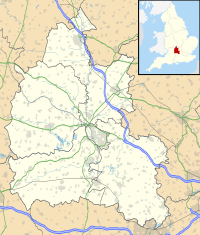Swerford Castle facts for kids
Quick facts for kids Swerford Castle |
|
|---|---|
| Swerford, Oxfordshire, England | |

The remaining earthworks
|
|
| Coordinates | 51°58′38″N 1°27′35″W / 51.9771°N 1.4598°W |
| Type | Motte and bailey |
| Site information | |
| Condition | Earthworks remain |
Swerford Castle was a medieval castle located in the small village of Swerford, in Oxfordshire, England. It was built a long time ago, in the 12th century.
About Swerford Castle
Swerford Castle was designed as a "motte and bailey" castle. This was a common type of castle built in England after the Norman Conquest.
Castle Design
A motte and bailey castle has two main parts. The "motte" is a large mound of earth. On top of this mound, a wooden or stone tower would have stood. The "bailey" is a larger, flat area next to the motte. This area was surrounded by a ditch and a fence, and it held buildings like houses and stables.
At Swerford, the central motte is about 18 meters (59 feet) wide at the top. It is 30 meters (98 feet) wide at its base and stands 4 meters (13 feet) tall. The bailey area is quite large, about 52 meters (170 feet) by 42 meters (138 feet). It was protected by a deep ditch.
Why Was It Built?
The castle was built in a smart spot. It overlooked a "ford," which is a shallow place where people and animals could cross the River Swere. This made it important for controlling movement in the area.
Experts believe the castle was built during a difficult time in English history. This period, known as "the Anarchy," was a civil war in the 12th century. It was a time when different groups fought for control of the country. Swerford Castle might have been built by the same family who also built Ascot d'Oilly Castle.
What Remains Today?
Today, you won't see a full castle at Swerford. What remains are mostly the earthworks. These are the big mounds and ditches that show where the motte and bailey used to be.
These remains are very important for history. They are protected as a "scheduled monument." This means they are a nationally important archaeological site. It helps make sure these historical remains are kept safe for future generations to learn from.


